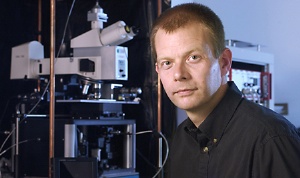Jul 7 2009
A century after German physicist Gustav Mie derived the math to explain why the colors in some stained glass windows look especially resplendent in the sunlight, a team of Stanford engineers has built upon his work to potentially improve a means of harvesting energy from the sun.

In 1907 Mie realized that tiny metal particles in stained glass scattered light in ways that produced beautiful colors. Now, a related interplay between light and matter explains why incredibly thin "nanowires" made of semiconductors like germanium may prove to be effective components for solar cells. Combining Mie's work with more recent theory, the Stanford team has discerned how to tune and improve the light absorption efficiency of the wires. Their research appears in the July 5 online edition of the journal Nature Materials.
"For many solar cells if you can get just a couple of percent improvement in energy conversion efficiency, people are very happy," said Mark Brongersma, an associate professor of materials science and engineering and a senior author on the paper. "Here we show that we can boost the light absorption by a factor of 10 for some wires at some wavelengths of light. Researchers around the world are already investigating the use of nanowires in solar cells and there is a potential to get significant boosts in their efficiencies."
Because the work explains how to improve light absorption with germanium, a material compatible with computer chips, it may also have applications in improving data communications by bridging optical and electronic signals, even in the smallest spaces on densely packed chips. (With a similar goal, a separate team of Stanford researchers recently demonstrated a way of producing strong light signals using a combination of silicon and germanium. Their research appeared in the June 8 edition of the journal Optics Express.)
In the work by Brongersma's team, the germanium nanowires were as thin as 10 nanometers in radius (1 nanometer is a billionth of a meter). They were grown by Joon-Shik Park, a visiting researcher from the Korea Electronics Technology Institute in the group of materials science and engineering Professor Bruce Clemens. Brongersma doctoral student Linyou Cao, the lead author on the paper and main driver of the research, hooked the germanium wires up electrically and showed that in the presence of visible and infrared light they act like wispy antennas, capturing particularly resonant wavelengths of the light and bouncing them around inside the wire. Because the resonant light bounces around for a while, it has a larger chance to be absorbed in the semiconducting material. When it is absorbed, it excites electrical charges in the material that can be measured as an electrical current from the wire. In a solar panel, that current is the electricity the panel generates.
The crux of the team's discovery is that different sizes of wire will absorb different frequencies of light more efficiently. The experimental results matched theory developed by Cao and simulations by doctoral student and co-author Justin White. The thinnest wires, say 10 billionths of a meter across, are good for absorbing red-orange light. Larger wires absorb longer wavelengths, stretching into the infrared part of the spectrum. To make optimal solar panels with germanium nanowires, it may be necessary to use a variety of nanowire diameters, or perhaps a specialized type of nanowire that shows resonances at several different wavelengths.
Engineers have become increasingly capable of making nanowires of different sizes, Brongersma says.
"Nanotechnology has provided us with an ever-increasing control over nanostructure dimensions and this control can now be used to engineer desired absorption spectra for specific applications," the authors wrote in the paper.
Also in the paper, the team figured out another parameter for tuning absorption: the angle at which light strikes the nanowires. Depending on the diameter of the wire, some angles will yield better absorption at some frequencies and other angles will yield better absorption at other frequencies.
Brongersma said the team's next goal is to build prototype solar cells that make use of the tuning guidelines established in the Nature Materials paper.
Also among the authors was Jon A. Schuller, an applied physics graduate student in Brongersma's group and an expert in resonant light-matter interactions at the nanoscale. Primary funding for the research came from the U.S. Air Force Office of Sponsored Research.
David Orenstein is the communications and public relations manager at the School of Engineering.